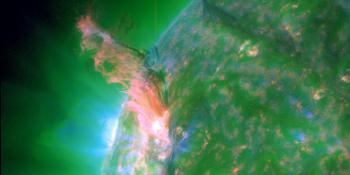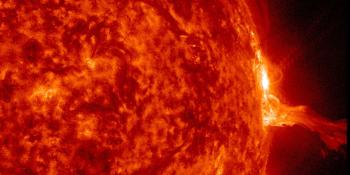Visualizzazione archivio di martedì, 13 maggio AM
Daily bulletin on solar and geomagnetic activity from the SIDC
Emesso: 2025 May 13 1231 UTC
SIDC Forecast
Brillamenti solari
C-class flares expected, (probability >=50%)
Geomagnetism
Quiet (A<20 and K<4)
Protoni solari
Quiet
| 10cm flux | Ap | |
|---|---|---|
| 13 May 2025 | 115 | 007 |
| 14 May 2025 | 114 | 007 |
| 15 May 2025 | 115 | 019 |
Solar Active Regions and flaring
Solar flaring activity was low over the past 24 hours, with only C-class flares. The strongest flare was a C2.7 flare (SIDC Flare 4373) peaking at 15:02 UTC on May 12, from beyond the east limb. There are currently six numbered active regions on the solar disk. The most complex one is SIDC Sunspot Group 494 (NOAA Active Region 4086, magnetic type beta-gamma). SIDC Sunspot Group 490 (NOAA Active Region 4081) has rotated behind the west limb. SIDC Sunspot Group 496 (NOAA Active Region 4087 magnetic type beta) has rotated on disk from the east limb. SIDC Sunspot Group 495 (magnetic type alpha) has emerged in the northwest quadrant. The solar flaring activity is expected to be low over the next 24 hours, with C-class flares expected and a chance for M-class flares.
Espulsioni di massa coronale
A faint, slow, full halo Coronal Mass Ejection (CME) was observed in the LASCO/C2 and C3 imagery starting from around 10:30 UTC on May 12. The CME has a projected velocity around 300 km/s. No clear source was identified on the visible disk, suggesting a backsided event that will not impact Earth. A wide CME directed to the north was observed in LASCO/C2 and LASCO/C3 coronagraph imagery starting from around 01:00 UTC on May 13. The CME is most likely associated with a long filament eruption observed in AIA 304 data around 23:00 UTC on May 12 near the central meridian in mid-latitude north hemisphere. This CME is expected to arrive at Earth starting from the UTC afternoon on May 16.
Vento solare
Over the past 24 hours, the solar wind parameters (ACE and DSCOVR) reflected mostly slow solar wind conditions. Speed values ranged between 360 km/s and 430 km/s. The interplanetary magnetic field values were between 7 nT and 13 nT. The Bz component varied between -3 nT and 11 nT. The interplanetary magnetic field angle was mostly in the negative sector. Slow solar wind conditions are expected over the next 24 hours.
Geomagnetism
Geomagnetic conditions globally were at quiet levels (NOAA Kp 1 to 2). Geomagnetic conditions locally were mostly at quiet levels (K BEL 2), with isolated intervals of unsettled levels (K BEL 3). Mostly quiet conditions are expected over the next 24 hours.
Proton flux levels
The greater than 10 MeV proton flux was below the 10 pfu threshold level over the past 24 hours. It is expected to remain below the threshold level over the next 24 hours.
Electron fluxes at geostationary orbit
The greater than 2 MeV electron flux measured by GOES 18 and GOES 19 was below the 1000 pfu threshold in the last 24 hours. The 24-hour electron fluence is presently at normal levels and is expected to remain so over the next 24 hours.
Today's estimated international sunspot number (ISN): 065, based on 26 stations.Solar indices for 12 May 2025
| Wolf number Catania | 073 |
| 10cm solar flux | 116 |
| AK Chambon La Forêt | 010 |
| AK Wingst | 008 |
| Estimated Ap | 006 |
| Estimated international sunspot number | 066 - Based on 30 stations |
Noticeable events summary
| Day | Begin | Max | Fine | Loc | Strength | OP | 10cm | Catania/NOAA | Radio burst types | |
|---|---|---|---|---|---|---|---|---|---|---|
| Nessuna | ||||||||||
Provided by the Solar Influences Data analysis Center© - SIDC - Processed by SpaceWeatherLive
Tutti gli orari in UTC
<< Vai alla pagina della panoramica giornaliera
Ultime notizie
Ultimi messaggi dal forum
Supporta SpaceWeatherLive.com!
Molte persone vengono su SpaceWeatherLive per seguire l'attività del Sole o sapere se ci sia la possibilità di vedere l'aurora, ma a maggior traffico corrispondono costi maggiori. Considerate una donazione se vi piace SpaceWeatherLive così che possiamo mantenere online il sito web!

Notizie sul meteo spaziale
| Ultimo brillamento X | 2025/05/14 | X2.7 |
| Ultimo brillamento M | 2025/05/15 | M2.1 |
| Ultima tempesta geomagnetica | 2025/05/03 | Kp5 (G1) |
| Giorni senza macchie | |
|---|---|
| Ultimo giorno senza macchie | 2022/06/08 |
| Media mensile Numero di Macchie Solari | |
|---|---|
| aprile 2025 | 140.6 +6.4 |
| maggio 2025 | 71.5 -69.1 |
| Ultimi 30 giorni | 98.8 -24.2 |


